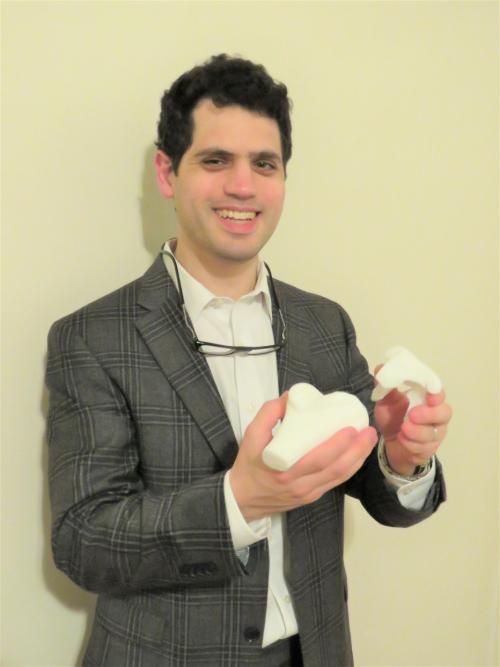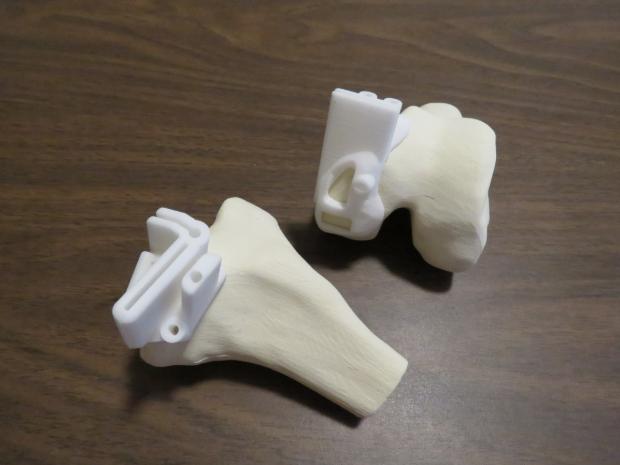- FMA
- The Fabricator
- FABTECH
- Canadian Metalworking
Our Publications
Categories
- Additive Manufacturing
- Aluminum Welding
- Arc Welding
- Assembly and Joining
- Automation and Robotics
- Bending and Forming
- Consumables
- Cutting and Weld Prep
- Electric Vehicles
- En Español
- Finishing
- Hydroforming
- Laser Cutting
- Laser Welding
- Machining
- Manufacturing Software
- Materials Handling
- Metals/Materials
- Oxyfuel Cutting
- Plasma Cutting
- Power Tools
- Punching and Other Holemaking
- Roll Forming
- Safety
- Sawing
- Shearing
- Shop Management
- Testing and Measuring
- Tube and Pipe Fabrication
- Tube and Pipe Production
- Waterjet Cutting
Industry Directory
Webcasts
Podcasts
FAB 40
Advertise
Subscribe
Account Login
Search
3D-printed devices improve surgical outcomes
Additively manufactured surgical tools and simulated body parts dramatically shorten surgeries
- By William Leventon
- October 3, 2019
- Article
- Additive Manufacturing

Medical experts from Yale, 3D Systems, and Mayo Clinic discuss how 3D printing improves surgical outcomes. Mayo Clinic
The 3D printer may soon be as essential a tool to modern surgeons as the scalpel. Doctors today are using printed objects to plan and assist in surgeries—a development that is yielding major benefits for themselves and their patients.
Printers also are faster than ever at turning out a variety of implants that are better at meeting the needs of particular surgical applications.
At Yale Medicine, Yale School of Medicine’s practical clinic, orthopedic surgeon Daniel Wiznia uses printed objects a couple of different ways. Before performing a surgery, for example, Wiznia builds a 3D-printed model of the bone anatomy he’ll be working on. He prints these hard plastic models himself using a Replicator+ machine from MakerBot.
“I use the MakerBot when I’m planning a complex surgery to understand the anatomy better,” Wiznia said. “When I print out the abnormal bone, I can trial out the surgery with the instruments outside of a sterile environment and also try out implants to see how they will fit before the surgery.”
During the actual surgery, Wiznia uses 3D-printed cutting guides supplied by a vendor. “I don’t use 3D-printed objects from the MakerBot in surgery because we don’t have a system to sterilize them,” he explained.
Before a total knee-replacement surgery, for instance, he’ll start out by taking an MRI of the patient’s knee. Then he uses software to create a virtual model that helps him decide what size and type of implant to select and how to orient it.
This information is turned over to a vendor that prints a surgical instrument from Nylon-12. The vendor certifies that the instrument is sterile and can withstand the stresses that will be placed on it during surgery.
The instrument itself, which Wiznia calls a jig, is designed to conform to the unique size and shape of the patient’s bone and snaps on in a specific position. The jig has slots where Wiznia will place his saw to create cuts in the exact locations he planned when modeling the surgery on his computer.
With this assist from 3D printing, Wiznia claims he can shave 15 to 25 minutes off a 90-minute surgery, thereby lowering the risk of infection. He also makes fewer cuts in the bone, which lessens pain, loss of blood, and the number of transfusions needed.
Another major benefit of 3D printing is more accurate implantation. As a result, implants function better and last longer because they won’t be subjected to stresses that they were not built to handle.
“If an implant has the wrong orientation, it may only last 10 years instead of 20,” he noted.
On the downside, it takes about three weeks for printed objects to be made, sterilized, and delivered to the hospital. “Patients tend to want their surgeries immediately, but with 3D printing there is going to be a little lag time,” Wiznia said.
Additive for Others
One of the companies that prints products for surgeons like Wiznia is 3D Systems, a Rock Hill, S.C., manufacturer of 3D printers. In addition to anatomical models and cutting guides, the company produces metal implants with its DMP (direct metal printing) printers, according to Jeph Ruppert, director of the company’s Customer Innovation Center. (Note: The original text incorrectly reported that 3D Systems made the implants with selective laser sintering.)
In the implant area, Ruppert said, advances in computing power and software have improved the design of porous structures, which allows printing processes to mimic the actual properties of bone more closely.
“Today we can create an infinite [variety] of porous structures to meet a customer’s clinical needs when it comes to things like pore size, bone in-growth, and bone on-growth,” he said. “And we can do this very fast now with off-the-shelf software.”
For a patient, the result might be less sinking (subsidence) of a spinal implant into bone, for example, because the metal implant more closely matches the bone modulus.
For those involved in additive manufacturing of medical devices, Ruppert said, benefits are coming from recent advances in process monitoring. Data from in-process monitoring allows manufacturers to assess the quality of parts after the build phase rather than testing them after completion of the manufacturing process.
“With medical devices, there is always some level of postprocessing,” Ruppert said. “If you’re finding that you have produced a nonconforming part at process 29 of 30 in final quality control, you’ve added a tremendous amount of time and value to a part you’re not able to use.”
As for the printing of anatomical models and surgical instruments, Ruppert sees these functions beginning to move out of service centers. Take, for example, the process of creating single-use instruments for a surgery, which begins with the surgeon and a biomedical engineer planning cut locations. Then a manufacturing group takes this plan and prints the instruments.

Yale Medicine orthopedic surgeon Daniel Wiznia holds additively manufactured cutting blocks used for knee-replacement surgery. Yale
Rather than processes like this always taking place in facilities like 3D Systems’ surgical planning center, the idea is to move some of them to the point of care. This more distributed model allows health-care providers to work faster and be more agile, Ruppert said.
3D Systems, he added, is working to enable this shift on a larger scale by providing hospitals with the necessary hardware and software know-how.
3DP at the POC
A point-of-care pioneer is the Mayo Clinic, which has been printing anatomical models for its own surgeons since 2006.
According to Amy Alexander, a senior biomedical engineer at the Anatomic Modeling Laboratory in the clinic’s department of radiology, “CT and MRI images are basically black-and-white pixels on a page. If you’re trained, you can use so-called mental gymnastics to render these black-and-white images into a 3D rendering in your mind. But 3D models take mental gymnastics out of it by creating something tactile and to scale.”
For surgical planning, she added, “It’s really meaningful to have a 3D model you can pass around a conference room to members of the surgical team. Surgeons can even take a Sharpie® and draw a dotted line where they plan to separate a tumor from healthy tissue.”
Alexander’s department uses seven 3D printers that employ different technologies, each of which has its pros and cons and offers different material options. In addition to anatomical models, Alexander and her colleagues work with surgeons to plan where they want to make cuts and then turn these plans into printed guides.
They also make models that accurately mimic tissue properties for training purposes. “To teach new surgeons how to stitch up a heart valve, the old method is to buy a bunch of cadaver hearts and let each person have a go at stitching that valve,” Alexander said. “But we can generate a multitude of models with the same tissue properties and have them practice on silicone or other polymers instead of on human tissue.”
These models are much cheaper than cadaver organs and also much less stressful to practice on, she noted.
Why is 3D printing the best choice for making medical structures at the clinic? Most traditional manufacturing processes are “very industrial,” requiring factories and staff to run them, she said. “Whereas 3D printing has become so commercial that you can put printers in your office and generate objects out of basic materials that you can order on Amazon.”
Although the clinic produces many medical devices, it currently does not make implants. However, Alexander reports that the division of engineering has purchased a titanium 3D printer with the goal of designing and printing patient-specific implants instead of paying a third party to do the work.
This is made possible, she said, “because of the way the technology has evolved and become more accessible—especially for larger centers like the Mayo Clinic that have resources to build their own point-of-care manufacturing centers that can follow FDA quality-management guidelines.”
About the Author

William Leventon
(609) 926-6447
About the Publication
- Podcasting
- Podcast:
- The Fabricator Podcast
- Published:
- 04/16/2024
- Running Time:
- 63:29
In this episode of The Fabricator Podcast, Caleb Chamberlain, co-founder and CEO of OSH Cut, discusses his company’s...
- Trending Articles
- Industry Events
16th Annual Safety Conference
- April 30 - May 1, 2024
- Elgin,
Pipe and Tube Conference
- May 21 - 22, 2024
- Omaha, NE
World-Class Roll Forming Workshop
- June 5 - 6, 2024
- Louisville, KY
Advanced Laser Application Workshop
- June 25 - 27, 2024
- Novi, MI





























